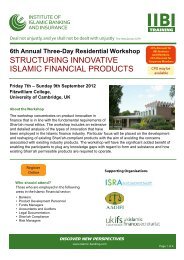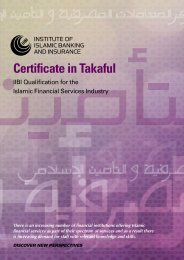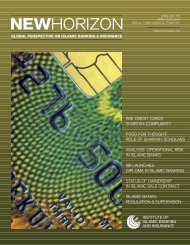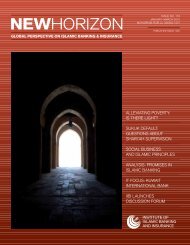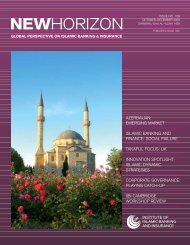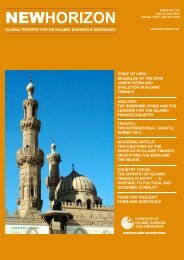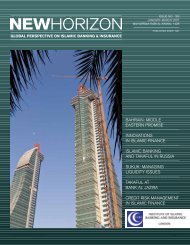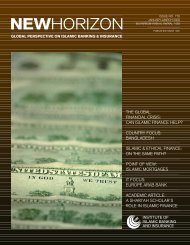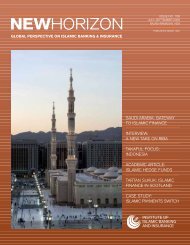HORIZON
issue no. 183 - april–june 2012 / jumada-al-awwal - Institute of ...
issue no. 183 - april–june 2012 / jumada-al-awwal - Institute of ...
- No tags were found...
You also want an ePaper? Increase the reach of your titles
YUMPU automatically turns print PDFs into web optimized ePapers that Google loves.
ANALYSIS<br />
NEW<strong>HORIZON</strong> April–June 2012<br />
offer in exchange for their Existing<br />
Certificates.<br />
7. On the settlement date, the obligor will<br />
surrender to SPV 1 for cancellation the<br />
Existing Certificates acquired by it,<br />
pursuant to either the tender offer and/or<br />
the exchange offer.<br />
It is possible that certain holders of the<br />
Existing Certificates did not participate<br />
in either the tender or exchange offer. In<br />
such circumstances, the obligor, on the<br />
settlement date (which will now also be<br />
the maturity date of the Existing<br />
Certificates), will exercise its rights under<br />
a unilateral sale undertaking and make a<br />
payment of the exercise price (being an<br />
amount equal to all amounts due and<br />
payable under the Remaining<br />
Certificates) to SPV 1. SPV 1 will then<br />
pass on the proceeds of the exercise price<br />
to the holders of Remaining Certificates<br />
in order to redeem the Remaining<br />
Certificates and thereby enable the<br />
collapse of the structure in its entirety.<br />
8. SPV 1 will transfer the sukuk assets to<br />
the obligor in consideration for the<br />
surrender of the Existing Certificates and<br />
payment of the exercise price by the<br />
obligor in step 7 above.<br />
Effects of the Sukuk Restructuring and<br />
Additional Observations<br />
Following settlement as described in steps<br />
five to eight above, the obligor will have<br />
discharged in full its obligations with respect<br />
to the Existing Certificates and the Existing<br />
Certificates will therefore cease to exist.<br />
Instead, the obligor will have obligations<br />
under the New Certificates to those investors<br />
who chose to accept the exchange offer. The<br />
terms of the New Certificates may include a<br />
longer maturity and may also carry a higher<br />
rate of return in order to have induced<br />
investors to accept the exchange offer. The<br />
obligor will also have used cash reserves for<br />
the purpose of the tender offer to retire a<br />
portion of Existing Certificates in order to<br />
extinguish some of its liabilities going<br />
forward. From a commercial standpoint, the<br />
implementation of the sukuk restructuring<br />
allows the obligor to manage its obligations<br />
by putting it in the same position as a<br />
conventional bond issuer that implements a<br />
liability management strategy involving a<br />
tender and exchange offer and a consent<br />
solicitation, albeit with some additional<br />
steps and considerations. Despite the added<br />
complexity of restructuring sukuk<br />
transactions, the problems are not without<br />
solution as evidenced by recent public<br />
transactions, such as the Government of Ras<br />
al Khaimah liability management transaction<br />
and the Nakheel trade creditor sukuk.<br />
We also note that another (untested)<br />
example of a capital markets solution to<br />
liability management could take the form of<br />
a debt-for-equity swap. Here, a company’s<br />
creditors may agree to cancel some or all of<br />
the company’s debt owed to them in<br />
exchange for an equity stake in the business.<br />
This option could be favoured in<br />
circumstances where the business is not<br />
generating sufficient revenue to continue to<br />
fund payments on any restructured debt<br />
capital markets instrument. Given that a<br />
sukuk certificate effectively represents an<br />
undivided beneficial ownership interest in an<br />
underlying income-generating asset, sukuk<br />
investors might find such an exchange offer<br />
particularly appealing as it would effectively<br />
represent an exchange of one type of equity<br />
interest (in the asset underpinning the sukuk)<br />
for another (equity in the obligor) at a<br />
negotiable price. However in a market,<br />
which to date has been dominated by noncorporate<br />
issuers, it remains to be seen how<br />
practical debt-for-equity swaps will be for<br />
obligors with government-backed entities as<br />
majority shareholders.<br />
Conclusion<br />
Although the challenges in each liability<br />
management exercise for a sukuk will be<br />
different, depending on the commercial<br />
rationale and, most notably, the underlying<br />
Islamic structure, these challenges are not<br />
insurmountable and it is possible to<br />
implement restructurings, which have the<br />
same commercial effect as for an obligor<br />
seeking to manage its outstanding liability<br />
under a conventional transaction.<br />
As the current global economic volatility<br />
continues, it is likely that obligors under<br />
sukuk transactions will become increasingly<br />
interested in managing their liabilities by<br />
restructuring their existing sukuk<br />
obligations. Recent sukuk transactions have<br />
demonstrated that obligors are keen to<br />
establish sukuk programmes in place of<br />
standalone sukuk issuances in order to<br />
provide maximum future flexibility vis-à-vis<br />
liability management and we see this trend<br />
continuing. Indeed, many of the new sukuk<br />
transactions, which have been structured<br />
post the Dubai World standstill<br />
announcements, contemplate future liability<br />
management strategies from the outset.<br />
They do this by incorporating structural<br />
features, such as buyback and cancellation<br />
mechanics, which would facilitate the<br />
restructuring of such transactions in the<br />
future, thereby reducing the reliance on<br />
complex and potentially time-consuming<br />
restructurings. These developments continue<br />
to demonstrate the growing maturity and<br />
versatility of the sukuk market and the<br />
adaptability of conventional capital markets<br />
technology in a Shari’ah-compliant manner.<br />
As the current global<br />
economic volatility continues,<br />
it is likely that obligors under<br />
sukuk transactions will<br />
become increasingly interested<br />
in managing their liabilities by<br />
restructuring their existing<br />
sukuk obligations.



